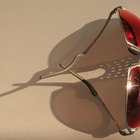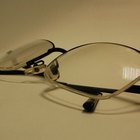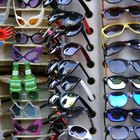Eyeglass frames can hold a variety of lenses. Because people have different problems with their vision or require certain characteristics from their glasses lenses, eyeglass companies manufacture specific types of lenses to accommodate these needs. Polarized and polycarbonate lens types vary by shape and composition.
Shape
polycarbonate lenses are shaped like most other lenses in a spherical shape. Polarized lenses are also spherical. The difference is shape between the two lenses is that polycarbonate lenses are typically lighter than polarized lenses. In fact, some polycarbonate lenses are up to 35 percent lighter and thinner than regular plastic lenses, according to Frames Direct.
Composition
Polycarbonate lenses were the first plastic high index lenses. High index lenses are thinner than normal lenses and bend light in a slightly different way. Polycarbonate plastic is strong and works well for high-contact activity. Polarized lenses are also made of plastic, but they also contain a special filter that prevents "intense reflected light, reducing glare," according to All About Vision.
Purpose
Polycarbonate lenses are popular because of the thin look they give to the frames and the strength the high index plastic provides. Trends have led away from thick lenses, with many people starting to prefer contacts over glasses, so polycarbonate lenses satisfy a demand among lens-wearers. Polarized lenses block out glare from the sun, enabling people to see more clearly. Photochromic polarized lenses also block out glare but also change from light and clear inside to a darker shade outside.
Uses
Lenses made of polycarbonate plastic are most often used in high-contact activities, like sports. Parents often buy polycarbonate lenses for their children, as kids are usually active and do not always take the best care of their glasses. Polarized lenses are popular for anglers who want to see more clearly into the water and do not want to experience the sometimes intense glare off the surface of the water. These lenses are also common for people who have to travel or drive a lot and do not want the glare of the sun through windshields.
Related Articles

The Difference Between Polycarbonate & ...

Levels of Polarized Sunglasses

Amber Vs. Grey Sunglasses

The Best Photochromic Sunglasses

The Effects of Red Lens Sunglasses

Rimless vs. Full Rim Glasses

How Do Yellow Lenses in Ski Goggles ...

Tanning Beds and Eye Disorders

How to Spot Fake Serengeti Sunglasses

How Does Ultraviolet Light Affect ...

The Best Sunglasses for Kayaking

10 Facts About Eyeglasses

How to Remove the Anti-Reflective ...

How Many Calories in One Piece of ...

Environmental Impact of Disposable ...

The Benefits of Yellow Lenses in ...

How to Make Marshmallow Creme Smooth ...

How to Make Custom Clip-On Sunglasses

How to Make Glowing Ice Cubes From ...

Icon Alliance Face Shield Replacement ...
References
Writer Bio
Residing in Bristol, Va., Mitchell Land began writing for various websites in 2010. He worked as a writing center tutor at Baylor School for three years, where he also contributed music reviews to "Baylor Notes." He attends Greensboro College in North Carolina and studies theater and French.